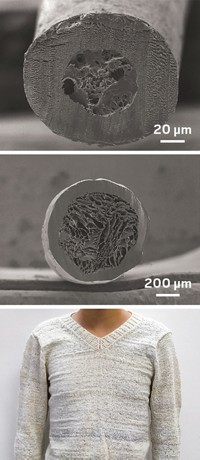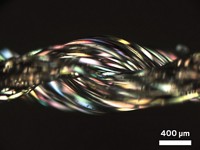Advertisement
Grab your lab coat. Let's get started
Welcome!
Welcome!
Create an account below to get 6 C&EN articles per month, receive newsletters and more - all free.
It seems this is your first time logging in online. Please enter the following information to continue.
As an ACS member you automatically get access to this site. All we need is few more details to create your reading experience.
Not you? Sign in with a different account.
Not you? Sign in with a different account.
ERROR 1
ERROR 1
ERROR 2
ERROR 2
ERROR 2
ERROR 2
ERROR 2
Password and Confirm password must match.
If you have an ACS member number, please enter it here so we can link this account to your membership. (optional)
ERROR 2
ACS values your privacy. By submitting your information, you are gaining access to C&EN and subscribing to our weekly newsletter. We use the information you provide to make your reading experience better, and we will never sell your data to third party members.
Materials
Redesigning Silk
Materials: Reprocessing confers spider-silk qualities on silkworm silk
by Jyllian Kemsley
October 12, 2009
| A version of this story appeared in
Volume 87, Issue 41

Silk from silkworms can be reprocessed to give it spider-silk properties, according to a new report (Macromolecules, DOI: 10.1021/ma9017235). The reprocessing method gives researchers a new way to design silk fibers with customizable features.
The work was done by an international research group led by Gustavo R. Plaza and Manuel Elices, materials science professors at Polytechnic University of Madrid.
Silk has long been prized for its strength and ability to absorb energy, but silks from silkworms and spiders exhibit different characteristics. Material from silkworms tends to be stiffer and less elastic, geared toward protecting a pupa as it develops into a moth. Spider silk, in contrast, can better absorb and dissipate the energy of prey striking a web and can recover its properties after wetting and drying.
Cocoons can provide plenty of silkworm silk, but spider silk is much harder to obtain. Many researchers have tried to prepare spider silk in the lab (see page 72), in particular by using genetically engineered microorganisms or microfluidic devices, says Randolph V. Lewis, a molecular biology professor at the University of Wyoming. The new reprocessing approach is the closest anyone has come to endowing silkworm material with spider-silk properties, he says.
The reprocessing involves solubilizing silkworm silk, extruding it into a methanol coagulation bath, drawing it through a water bath, and finally collecting it on a spool.
The water bath appears to be the key step in giving silkworm silk supercontraction and recovery capabilities that are closer to those of spider silk. It’s not clear what the reprocessing does to the silk, Plaza says, but he speculates that it might be related to reducing the number of protein entanglements in the fibers.
The advance should enable fabrication of silk with specific properties, just as spiders themselves can customize their silk for building a web or fleeing a predator, Plaza says.





Join the conversation
Contact the reporter
Submit a Letter to the Editor for publication
Engage with us on Twitter